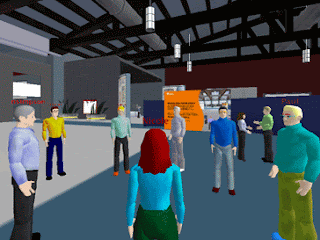
Excellent look at Sun's Virtual World by CIO Magazine;
Inside Sun's Virtual World for Internal Collaboration - C.G. Lynch, CIO January 11, 2008 "During the past couple of years, virtual worlds have received a lot of media attention, especially Second Life, the virtual environment created by Linden Lab that 1.3 million people actively use to play games, do business and live alter egos via their avatar stand-ins. But when Sun Microsystems thought about how it could use a virtual world to improve internal collaboration and facilitate social interactions among its 33,000 employees, spread out across offices around the world and in numerous home telecommuting sites, it began to think about building its own virtual world behind the firewall. Thus, Project Wonderland was born. Started about a year ago as a collaborative effort between Sun and the open-source community, Wonderland is a virtual, 3-D website that allows people to build virtual worlds based on Java programming. Sun’s internal world, MPK20, was built on this platform and started in June 2007. The name stems from the company’s Menlo Park, Calif., corporate campus, which has 19 buildings (MPK1 to MPK19), making MPK20 the virtual world extension. While the group building and developing MPK20 spends the most time in it, Sun hopes to start bringing in more user groups in the coming months. CIO.com’s C.G. Lynch visited Sun’s labs in Burlington, Mass., to see MPK20 for his own eyes and talked with Nicole Yankelovich, who works as the primary investigator at the company’s collaborative environments group.
CIO.com: What led Sun to start building a virtual world for its employees? Was there a tipping point that spurred it?
Nicole Yankelovich: About a year ago, we informally did a study by interviewing a bunch of our employees who work from home. Meanwhile, we tracked the statistics of how many people badge into our facilities each day. We found that many people worked from home full time, and some at least part time. This isn’t bad. [Without the commute] they often work longer hours and are very productive. Meanwhile, we also have a lot of people traveling to visit with our customers.
In the end, what we found was on any given day, more than half of our employees are working remotely. There are a lot of good benefits of a distributed workforce, but there are also some drawbacks. What they’re missing is the social interaction. We know, from business literature, that social interaction is very key to good business outcomes. You need to be able to trust people in order to get work done effectively or negotiate in business. Virtual worlds seemed like a great opportunity to address this problem.
What makes virtual worlds more compelling for that social interaction than existing technologies, such as phone and video conference?
Up until now, Sun, like most companies, has used audio conferencing. We’ve used a little bit of video conferencing too, but a lot people working at home don’t have video because that’s their personal space. So we mostly use audio conferences. The problem with this is we’re not getting the social interaction and the informal brainstorming you’d get in person. We figured [we] can create a virtual world where you can begin to re-create that social interaction, and then we could really create a wonderful place to bounce ideas off each other, both as a group or just between two people.
The consumer virtual worlds, like Second Life, have seen pretty significant user adoption. With that comes the need to scale. When you think about Sun's virtual world and getting thousands of employees on it, how will you plan for scale?
Second Life and other online games use this process called sharding. This means pieces of the virtual world are hosted on specific servers. So servers will have their capacity, and when it fills up, it fills up. For example, if a bunch of people decide to visit an island in Second Life, and that island begins to fill up with avatars, so does the server assigned to it. Meanwhile, you have all of these other unused servers. This is a huge problem in almost all the multiplayer games.
So at Sun we decided we’d use Darkstar, our game server. It’s a scalable platform that doesn’t do sharding. Instead, the [virtual world] developers write their applications as if they’re on one giant server. Then the underpinnings of the Darkstar servers allocate resources as they're needed. If one server starts to fill up and get near capacity, it goes to another one.
When will something like this become available for large enterprises?
Right now, Project Wonderland is open source and people are free to use it. But this whole project has been more popular with people initially than we thought it might be. So we have started to work with business development to see what Sun could do for customers. Maybe we could provide hosted services, or even manage the service (and server) for them behind the firewall. There are a lot of different models to explore. But for right now, we want to get more people using it here internally.
From www.cio.com

No comments:
Post a Comment